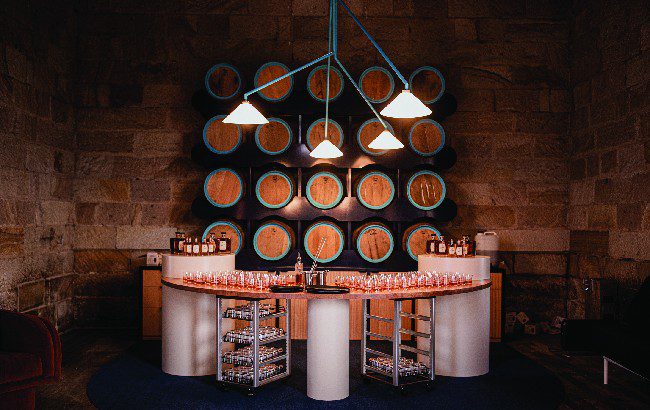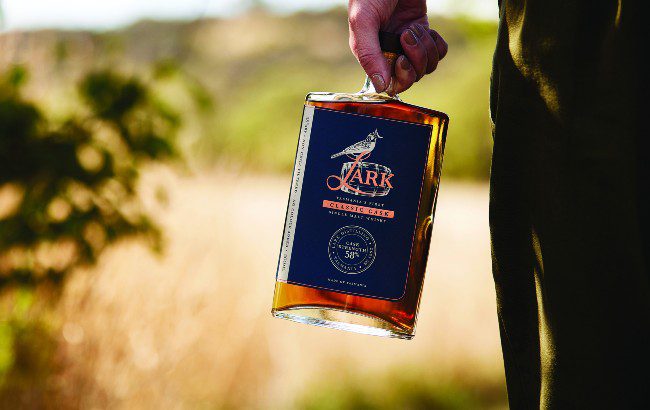The big interview: Bill Lark
Along with his wife, Lyn, Bill Lark is a pioneer of Tasmanian whisky production. Now, 30 years later, he tells Melita Kiely how they turned their dream into a reality.

What does trout fishing have to do with Tasmanian whisky, you might ask. Well, quite a lot because if it weren’t for a fishing trip in 1989 today’s thriving Tasmanian whisky scene might never have existed.
Bill Lark had been on a fishing day out with his father-in-law in 1989 when inspiration struck.
“We were sitting up in the highlands of Tasmania and reflecting on the fact that Tasmania had some of the best water in the world, and our barley was obviously pretty good because we knew our local bees were being exported all over the world,” Lark recalls. “And we thought our climate seems OK for making whisky, yet no one was making it. We talked about this for a little while, and my wife turned up and she said, ‘well, let’s give it a go’.”
Prohibition in Tasmania
Lark and his wife, Lyn Lark, soon learned about Tasmania’s antiquated distillation laws. The region had enjoyed a short-lived foray in whisky production when The Sorell Distillery was opened in 1822. A further 16 legal distilleries were dotted around the island (along with some illicit sites). But Lady Jane Franklin was averse to whisky, and convinced her husband, governor John Franklin, to prohibit distillation in Tasmania in 1838.
Although the distillation act of 1901 permitted distillation with a minimum still size of 2,700 litres, it made it challenging for those with an interest in spirits distillation to pursue anything seriously.
“We were being stymied by regulation,” Lark says. “But the enthusiasm from within Tasmania, and, indeed, in Australia, was from our federal politicians, who helped us instantly amend the legislation to allow small-scale distilling to start again in Tasmania. Lyn and I were the first ones to get a licence.”
That was in 1992, when the Lark household became the first Australian distillery to make single malt spirit in 154 years. “It was quite something,” Lark notes humbly. Neither he, nor his wife, had any experience in distilling. Lark was a land surveyor, and Lyn was a survey draftsman.
“I was sitting at home thinking ‘what the heck do we do now?’,” Lark recalls. “Within two weeks of getting our licence I had a phone call at 10 o’clock at night, and it was John Grant from the Glenfarclas distillery [in Scotland] on the other end,” he adds with surprise. “He goes to me ‘my distributor in Hobart tells me you’ve got a licence to make whisky. Would you let me help you make good whisky?’ So all the stars kept aligning, people wanted to help us; it was just fantastic.”
Lark sourced wash from the nearby Cascade Brewery, and he found a “beautiful copper pot whisky still at a local auction for about AU$65 or so”. As a result, the husband-and-wife duo’s residential cul-de-sac became the first licensed distillery in Tasmania.
“From there, we decided we needed to open some premises and take it out of home, and we moved to a small site in a lovely historic village just outside of Hobart, called Richmond,” in 1997, Lark explains. It was here that the pair set up a distillery and visitor centre, which started to attract attention from locals before “people started coming from all over Australia”.
The inaugural commercial Lark Distillery Single Malt Whisky was released in 1998. The next few years were a busy mix of juggling distilling, school runs for the children, while the pair were still doing their day jobs. “Once we started selling product, we just found we needed to be open seven days a week,” Lark says. “We needed to make more product. By then, we had the confidence to think that we could actually make a living from this, and in 2000 I sold my survey practice to my associate and left surveying, and both Lyn and I went full time in the distillery.”

Catalyst for the movement
Lark Distillery was indisputably the catalyst for the Tasmanian whisky movement. By 2000, Lark recalls, there were six distilleries in the island state. Lark describes them all as “good mates”, and credits the support he received from Glenfarclas’ Grant, from the other side of the world, for the community they’ve built today in Tasmania.
“I said to John [Grant] at the time, can I ask why you would offer to help us, and he said, ‘well, Bill, if somebody comes to your distillery and they’re trying your whisky, and it’s their first experience with whisky, I’d like it to be a good experience. And then they’ll probably go on to explore the greater world of whisky,’” Lark remembers. “We didn’t intend to start as a business, but we were growing into one, and I had those words of John ringing in my ear. As other producers came along, I thought I should help them as well, and perhaps that way we could go beyond being just a novelty; we could become a business and an industry that people actually come looking for.”
In the past year, Lark Distillery has enjoyed serious growth. In late 2021, the producer opened the doors to The Still, a whisky complex comprising a bar, tasting room, and shop. Located in the Old Mercury Print Room in Argyle Street, Hobart, Tasmania, the venue aims to cater for newly curious whisky drinkers and seasoned aficionados alike, with more than 150 local whiskies available to buy by the glass or bottle.
Around the same time, Lark Distillery agreed to acquire the Kernke Family Shene Estate, owner of the Pontville Distillery and Estate, for AU$40m (US$29.9m). The deal included building a new one-million-litre distillery on the purchased land, with an aim to accelerate Lark Distillery’s export strategy. Construction is due to begin in 2023.
Pontville Distillery is situated 30 minutes north of Hobart in Pontville. It stretches across 40 acres of land and buildings, including a 130,000-litre distillery, eight bond stores, a working cooperage, stables, and homestead. Immersive visitor experiences have been running since March this year, covering the distillery and cooperage, and also giving the option to partake in a ‘blend your own whisky’ experience.
“Demand for Tasmanian whisky was growing exponentially,” explains Lark. “We had to do something; it was either move entirely, or try and grow around us. We couldn’t grow around us, but we knew of a distillery out at Pontville. They’d established quite a reasonable-sized one.”
Whisky produced at Pontville will be bottled and sold under the Lark brand, presenting a huge opportunity of growth for the company.

Lark’s portfolio is led by its single malt whiskies, including Classic Cask (43% ABV), and Cask Strength (58% ABV), as well as a selection of Forty Spotted gins. Lark Distillery has established a strong fanbase in its home country, which it hopes to take overseas in the next 12 months. A selection of Lark whiskies are already available in China, and the brand will also be heading to the US, Singapore, Vietnam, and other Southeast Asian markets in the coming year.
It’s an exciting period of change for Lark and the team, as 2022 also marks a major milestone for the company, Lark Distillery’s 30th anniversary. To celebrate the momentous occasion, Lark Distillery released a single malt whisky as part of its Rare Cask Series, called Rare Cask Para 92. Only 3,000 bottles of Rare Cask Para 92 were created, in partnership with Australian wine estate Seppeltsfield. The whisky was finished in rare Seppeltsfield Para Liqueur (fortified wine) casks from 1992, and sits at 46.4% ABV.
The unusual cask finishing ties into the company’s ethos that has been part of its strategy since the start. To produce the “big, bold, rich, intense whisky” he envisioned, Lark played with smaller casks. Australia housed a wealth of fortified wine brands, making cask experimentation extremely accessible to Lark.
There are further celebratory bottlings planned for this year. Most notable is a whisky from Glenfarclas to celebrate the first phone call between Grant and Lark in those early days.
“John managed to find a cask that was distilled at Glenfarclas in 1992, and he’s bottled that for us with his image on the label and my image next to it, to celebrate that phone call 30 years ago.”

There are now “nearly 50 distilleries in Tasmania that are dedicated single malt whisky distilleries”, notes Lark, almost 60 including those that are not. As the category grows, Lark is conscious of the need for some regulation “but not too much – more a definition of Tasmanian single malt whisky and what we’ve created”, he says.
“We need to make sure we look after the brand that’s taken us 30 years to establish, and we’re working towards actually defining or creating an appellation to say ‘this will be Tasmanian single malt whisky’,” Lark explains. “The thing that we’re all nervous about doing is that we don’t want to stifle innovation. We don’t want to make that appellation so tight that it doesn’t give us the ability to experiment with different barrel types and different finishes.”
And experiment he has. For the past two years, Lark Distillery has partnered with Tasmanian patisserie Jean-Pascal Patisserie to create a Christmas-inspired whisky. The patisserie selects Tasmanian red wine casks to fill with fruit jus that’s used to make its Christmas mince pies. The casks are then emptied and delivered to Lark Distillery to be filled with single malt whisky.
As the number of Tasmanian whisky producers grows, Lark is not the least bit fazed by the rising competition – if anything, he sees newcomers as crucial to helping the category blossom further. “The exciting thing for me is the bigger distillers coming into Tasmania,” he says. “For a long time it’s been regarded as a craft industry, and I think it still will for a long time yet, even though we now have some quite big distilleries down here capable of producing some serious volumes.”
As the founder and global ambassador of Lark Distillery, Lark is excited to see what the next 10 years hold for the company, and the wider Tasmanian whisky category. “I’ve always expressed the sentiment of ‘a rising tide lifts all boats’,” Lark says. “On our own, we’re not going to go very far, but if we all work together and produce good whisky, we’re all going to be successful in our own distilleries, and our industry will grow because of it.
“Lyn and I were there at the beginning, and we started this, and here we are still after 30 years. We’ve grown from Lyn and myself, operating the distillery on our kitchen table to a distillery that employs over 80 people, and was recently awarded ‘distiller of the year’ and ‘whisky of the year’ in the Australian Whisky Awards; it’s quite a humbling time.”
Lark took home the prestigious Lifetime Achievement Award at The Spirits Business Awards 2022.
The company was also named the winner of Best New Marketing Campaign for its Dark Lark 2022 Release, and awarded High Commendations in the Blender of the Year, Contribution to Spirits Tourism, and Best Event categories.
Related news
Hidden Barn names Molly Wellmann master taster
